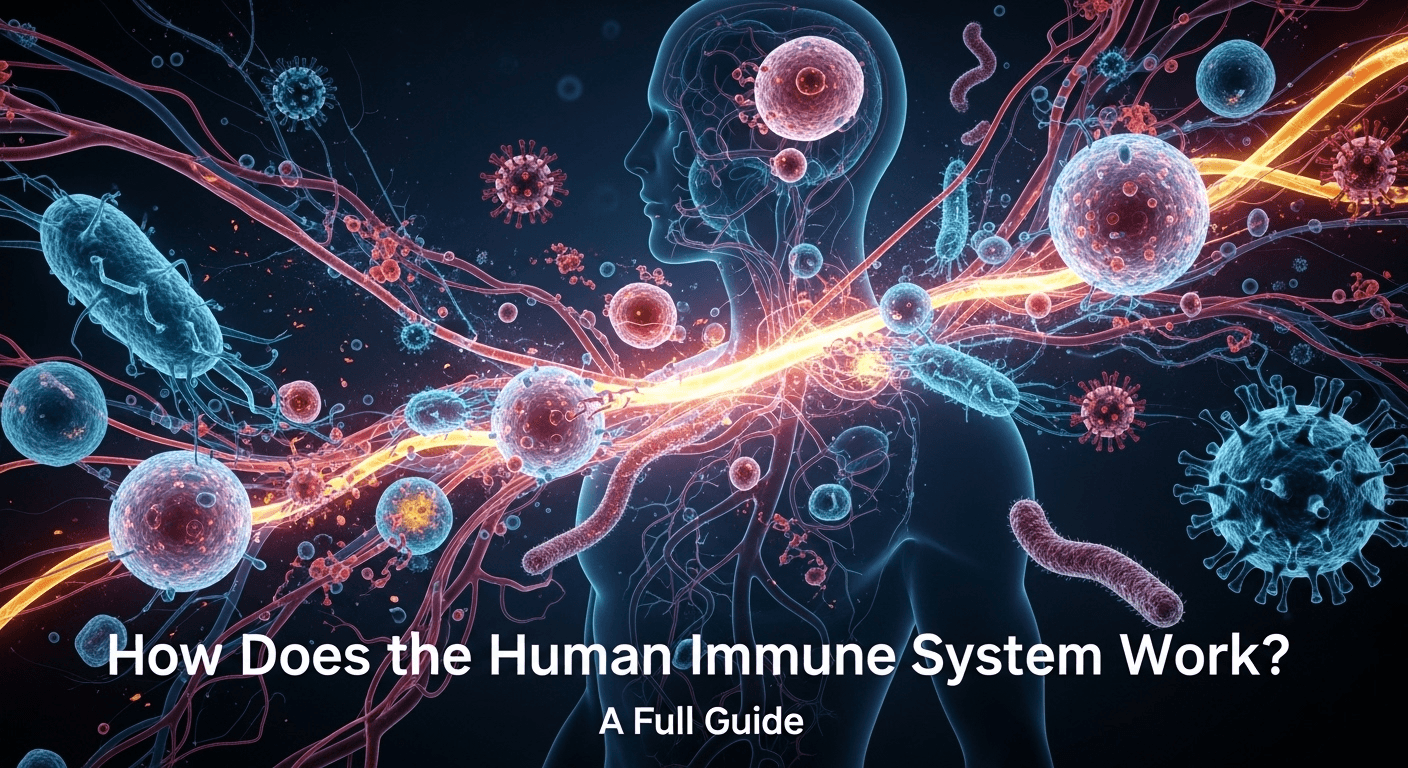Here is the article: — Your body is a fortress, constantly under siege by an invisible world of invaders: bacteria, viruses, fungi, and parasites. Yet, most of the time, you remain blissfully unaware of this relentless battle. This is all thanks to your immune system, a complex and highly sophisticated network of cells, tissues, and organs working in silent coordination to protect you. It is one of the most brilliant and intricate systems in biology, a vigilant guardian that learns, adapts, and remembers. But how does the human immune system work to orchestrate this incredible defense? This full guide will unravel the mysteries of your body's personal army, from its first line of defense to its highly specialized-strike forces. The Two Pillars of Immunity: Innate and Adaptive Systems The human immune system is not a single entity but is broadly divided into two fundamental and interconnected subsystems: the innate immune system and the adaptive immune system. Think of them as the general security guards and the highly trained special forces of your body. The innate system is your first and immediate line of defense, providing a rapid, non-specific response to any intruder it encounters. It's the system you are born with, ready to fight from day one. The innate system’s goal is simple: to prevent pathogens from gaining a foothold. It includes physical barriers like your skin, chemical barriers like stomach acid, and a squad of "first-responder" cells that attack any foreign substance they don’t recognize. This response is fast, often occurring within minutes to hours of an infection. However, the innate system has no memory; it treats every encounter with a pathogen, even a familiar one, as if it’s the first time. In contrast, the adaptive (or acquired) immune system is the specialist. It is more complex, takes longer to activate—typically several days—but its response is highly specific to the particular pathogen it is fighting. Critically, the adaptive immune system has a memory. Once it has fought off a specific invader, it "remembers" it, allowing for a much faster and more powerful response if that same pathogen ever tries to invade again. This immunological memory is the principle behind vaccines and the reason you usually only get diseases like chickenpox once. #### Delving into the Innate Immune System (Non-specific Defense) The innate immune system is the foundation of your body's defense. Its first component is a series of physical and chemical barriers. Your skin is the most obvious one, a tough, waterproof shield that keeps most pathogens out. Mucous membranes lining your respiratory, digestive, and urinary tracts trap invaders in sticky mucus, which can then be expelled. Other defenses include tears and saliva, which contain enzymes like lysozyme that break down bacterial cell walls, and the high acidity of your stomach, which destroys most pathogens you swallow. When a pathogen manages to breach these initial barriers—for instance, through a cut in your skin—the cellular part of the innate system springs into action. Specialized white blood cells called phagocytes (cell-eaters) are dispatched to the site. The most common types are neutrophils and macrophages. These cells engulf and digest invaders in a process called phagocytosis. This activity often leads to inflammation—the familiar redness, swelling, heat, and pain—which is actually a sign your immune system is working. The inflammation helps to contain the infection and signals for more immune cells to come and help. #### Understanding the Adaptive Immune System (Specific Defense) When the innate immune system is not enough to clear an infection, it calls for backup from the adaptive immune system. This system is defined by two main types of highly specialized lymphocytes (a type of white blood cell): B-cells and T-cells. These cells are unique because they can recognize specific parts of a pathogen, called antigens. Each B-cell and T-cell is programmed to recognize only one specific antigen, making the response incredibly precise. B-cells are responsible for the humoral immunity branch of the adaptive system. When a B-cell recognizes its matching antigen, and with help from a helper T-cell, it becomes activated. It then multiplies and transforms into plasma cells, which are essentially antibody factories. Antibodies are Y-shaped proteins that circulate in your blood and other body fluids. They don't kill pathogens directly but act like tags, binding to antigens and marking them for destruction by phagocytes or other immune components. Other activated B-cells become memory B-cells, which remain in your system for years, ready for a rapid response to a future infection. Key Players: The Cells and Organs of the Immune System The immune system is not located in one single place; rather, it is a vast, body-wide network. The components are strategically positioned throughout your body to provide a comprehensive surveillance and response system. The organs of the immune system are generally classified as primary and secondary lymphoid organs. The primary organs are where immune cells are created and mature into functional defenders. The secondary organs are the "battlegrounds" where these mature cells are stationed and where immune responses are initiated. The primary lymphoid organs are the bone marrow and the thymus. All immune cells, like all blood cells, originate from stem cells in the bone marrow. B-cells complete their maturation in the bone marrow itself (hence "B-cell"). T-cells, however, are immature when they leave the bone marrow and must travel to the thymus, a small organ located behind your breastbone, to mature and learn to distinguish between self and non-self (hence "T-cell" for thymus). This "education" process is crucial to prevent the immune system from attacking the body's own tissues. Once mature, lymphocytes migrate to the secondary lymphoid organs, which include the lymph nodes, spleen, tonsils, and Peyer's patches in the small intestine. Lymph nodes are small, bean-shaped structures connected by a network of lymphatic vessels. They act as filters, trapping pathogens from the lymph fluid that circulates throughout your body. The spleen filters the blood, removing old red blood cells and trapping blood-borne pathogens. These secondary organs are hotbeds of immune activity, where lymphocytes





